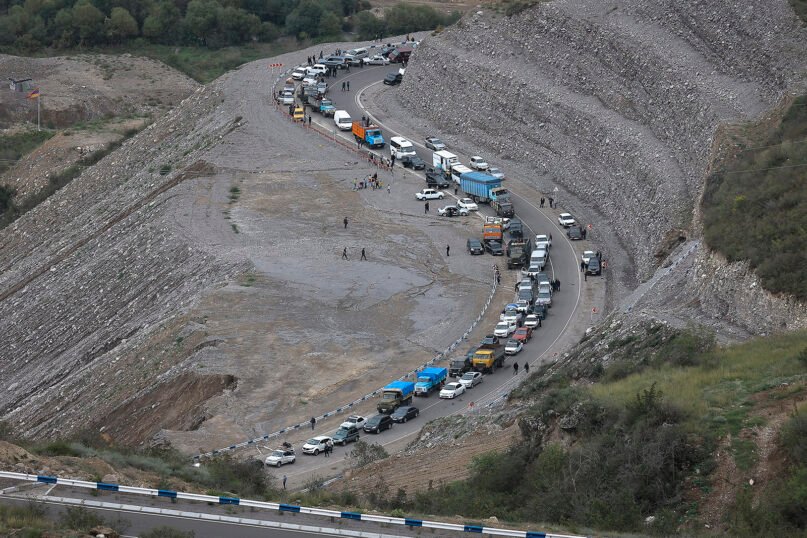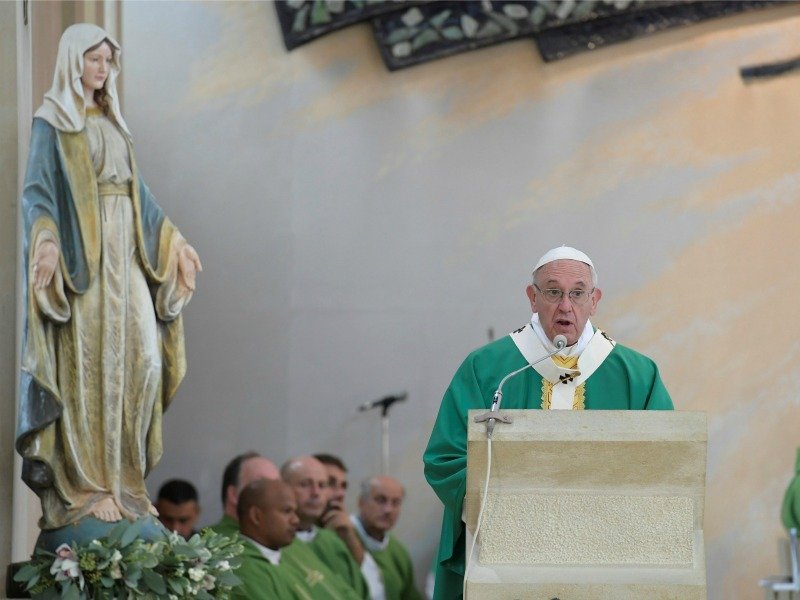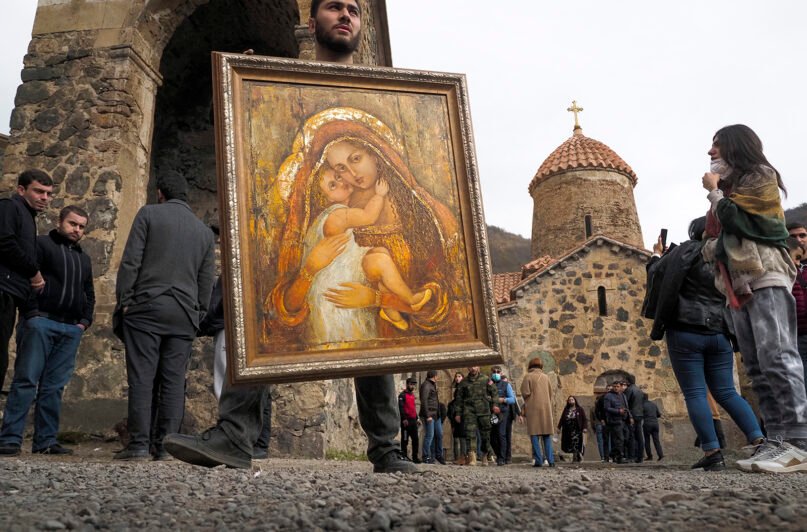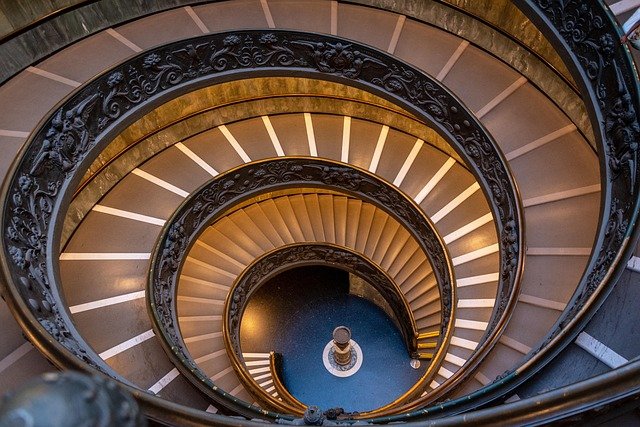VATICAN CITY (RNS) — As President Donald Trump hosts peace talks this week with the leaders of Armenia and Azerbaijan, two former Soviet states that have been in conflict for decades, Armenian activists continue to raise the alarm about the Vatican’s growing financial ties with Azerbaijan. They say the relationship is part of Azerbaijan’s broader effort to use its oil wealth to deflect criticism of human rights abuses and religious freedom violations.
The Vatican has received substantial Azerbaijani funding to restore holy sites in Rome and Europe. According to the Investigative Reporting Projects Italy, Azerbaijan has spent roughly 640,000 euros restoring Vatican-owned catacombs (most recently the Catacombs of St. Callistus), masterpieces of the Vatican Museums and numerous books and manuscripts in the Vatican’s Library. Azerbaijan also funded the restoration of a bas-relief adorning St. Peter’s Basilica depicting Pope Leo I’s meeting with Attila the Hun.
“They’re using their donations and their money to the Vatican to whitewash what they’ve done, to whitewash the destruction of Armenian heritage, to whitewash the ethnic cleansing that they’ve committed,” said Armenian-American Stephan Pechdimaldji, a communications strategist.
Over 350 scholars and professionals worldwide, including Pechdimaldji, denounced the Holy See in an April letter, accusing it of “moral bankruptcy” for hosting a conference, “Christianity in Azerbaijan: History and Modernity,” which they said legitimized the Muslim-majority country’s “cultural genocide” against Christian ethnic Armenians.
“Of all institutions, of all places in the world that you would think would side with us, you would think the Vatican would be on our side,” said Pechdimaldji, whose grandparents survived the Armenian Genocide of the early 20th century.
Since the 1980s, Armenia and Azerbaijan have fought wars over the disputed region of Nagorno-Karabakh, historically inhabited by both Armenian Christians and Azerbaijani Muslims. In 2023, Azerbaijan launched a military offensive and took control of the region, displacing more than 100,000 Armenians and destroying a number of Christian sites, including churches and cemeteries. Azerbaijani authorities argued that some of the Armenian Christian sites, such as the Gandzasar Monastery, were examples of Caucasian Albanian heritage and accused Armenia of falsifying historical inscriptions. These claims were disputed by Armenian and UNESCO representatives.

FILE – Ethnic Armenians flee Nagorno-Karabakh to Kornidzor, in Armenia’s Syunik region, Tuesday, Sept. 26, 2023. (AP Photo/Vasily Krestyaninov, File)
Azerbaijan has also come under fire by humanitarian groups and watchdog agencies for its arrests of journalists and other opposition figures. The U.S. Commission of International Religious Freedom listed the country, which requires religious groups to register with the government in order to operate legally, as “of particular concern” in 2024 and kept it on its watchlist in 2025 for violations of religious freedom. In 2024, when Azerbaijan hosted the COP29 United Nations climate summit in its capital, Baku, activists and global leaders called out the human rights violations in the country, but many religious groups stayed silent.
Pechdimaldji said many Armenians, including the diaspora, feel “disappointment” at the Vatican’s acceptance of Azerbaijan’s donations. “They are doing what other countries have been doing — turning a blind eye because of Azerbaijan’s resources,” he said.
The Ambassador of Azerbaijan to the Holy See, Ilquar Muxtarov, and the Apostolic Prefecture of Azerbaijan did not respond to Religion News Services’ request for comment.
The Armenian Ambassador to the Holy See, Boris Sahakyan, told RNS that he was not available for an interview until September.
The Vatican did not respond to requests in time for the publication of this article.
Azerbaijan has been campaigning to restore its credibility among Western nations for decades, under the leadership of Ilham Aliyev, who succeeded his father, Heydar Aliyev, as president in 2003. Leveraging its significant oil reserves, the country’s efforts to coax Western alliances through generous donations and lavish gifts has been dubbed by critics as “caviar diplomacy.”
Meanwhile, relations with the Holy See have been quietly growing, with a new memorandum signed July 25 underscoring their joint commitment to interreligious dialogue. Cardinal George Koovakad, prefect of the Dicastery for Interreligious Dialogue, praised the document as “a valuable instrument for promoting the principle of religious freedom.”
“The Vatican has been receiving money from Azerbaijan for some time,” said Orthodox Archbishop Vicken Aykazian of the Armenian Apostolic Church of America, in an April interview with the Pillar. In the interview, Aykazian pointed to the recent restoration of the Basilica of St. Paul Outside the Walls in Rome made possible through Azerbaijani funds.
The Azerbaijan donations flow through the Heydar Aliyev Foundation, run by Azerbaijan’s first lady, Mehriban Aliyeva, who is also the vice president of the country. In February 2020, she was awarded the highest civilian honor offered by the Holy See, the Papal Order of Knighthood of Pope Pius IX, just months before the country launched one of its efforts to capture Nagorno-Karabakh.
For the Vatican, the relationship with Azerbaijan offers quick cash for its struggling finances, but it’s also a continuation of the Ostpolitik launched by Cardinal Agostino Casaroli in the 1960s, aimed at improving relations with Communist countries in Eastern Europe. Today, similar efforts are led by the head of the Pontifical Council for Culture, Cardinal Gianfranco Ravasi, the Vatican’s Secretary of State, Cardinal Pietro Parolin, and the head of the department for Eastern Churches, Cardinal Claudio Gugerotti, who was the papal representative to Georgia, Armenia and Azerbaijan in the early 2000s.
During an official visit to the Heydar Aliyev Foundation in November 2024, Gugerotti praised the “policy of multiculturalism led by the government of Azerbaijan, the peaceful co-existence of representatives of different religions in the country, and the freedom of religion (as) the biggest contribution to peace,” according to the foundation’s website.
Gugerotti also thanked the foundation for building the new Catholic church in Baku.

FILE – Pope Francis leads a Mass at the Immaculate Conception church Oct. 2, 2016, in Baku, Azerbaijan. (Photo by Osservatore Romano)
Relations between Azerbaijan and the Holy See began in 1992, after it gained its independence from the Soviet Union. The now-Saint Pope John Paul II was the first pontiff to visit the country in 2002, which helped gain recognition for the Catholic community there. Pope Francis visited Baku in 2016, where he praised Azerbaijan as an example “that among followers of different religious confessions, cordial relations, respect and cooperation for the common good are possible.”
The Vatican’s balancing act has created tensions. Pope Francis twice used the word “genocide” to describe the 1915-1917 mass killings of Armenians by the Ottoman Empire, despite Turkish objections. But Vatican officials have been more circumspect about Azerbaijan’s recent actions against the Armenians.
Parolin visited both countries in July 2023, following the events of the Nagorno-Karabakh. In Baku, where Parolin celebrated the 30th anniversary of the relations between the Vatican and Azerbaijan, the country’s leaders rejected accusations of cultural genocide and accused Armenia of a “slander campaign.” In Armenia, Parolin acknowledged the “tragedy” of the Armenian genocide and promised the Holy See’s support. He also met with Karekin II, the Supreme Patriarch and Catholicos of All Armenians at the Holy Etchmiadzin Mother See, who highlighted the crisis of Azerbaijan’s blockage of the Lachin Corridor, which provides recourses to the Nagorno-Karabakh region.
Parolin emphasized the importance of having a permanent representation of the Holy See in the Armenian capital of Yerevan to improve relations.

FILE – A man holds a piece of art from the Dadivank, an Armenian Apostolic Church monastery dating to the 9th century, as ethnic Armenians leave the separatist region of Nagorno-Karabakh for Armenia, Saturday, Nov. 14, 2020. (AP Photo/Dmitry Lovetsky)
Despite diplomatic efforts by the Holy See, the relationship remains skewed in favor of Azerbaijan, which continues to funnel funds into the Catholic coffers. An article published in Vatican newspaper l’Osservatore Romano in July 2024 referred to ancient Armenian monasteries from the 9th-13th centuries in the Nagorno-Karabakh region as Caucasian Albanian.
“You can’t preach coexistence and then ink deals with a government that is destroying Christian churches,” Pechdimaldji said. “The Vatican isn’t just any government. It has a holy responsibility,” he added.
While experts predict the Trump-hosted talks are unlikely to produce a breakthrough — Azerbaijan demands Armenia amend its constitution before signing any peace treaty — the meeting has put new scrutiny on Azerbaijan’s international relationships, including with the Vatican.
“The Vatican needs to be careful who it aligns itself with,” Pechdimaldji said. “When you’re sitting at the same table with Trump and Aliyev and calling it peace, you’re legitimizing people who have no interest in actual peace.”
As an independent nonprofit, RNS believes everyone should have access to coverage of religion that is fair, thoughtful and inclusive. That’s why you will never hit a paywall on our site; you can read all the stories and columns you want, free of charge (and we hope you read a lot of them!)
But, of course, producing this journalism carries a high cost, to support the reporters, editors, columnists, and the behind-the-scenes staff that keep this site up and running. That’s why we ask that if you can, you consider becoming one of our donors. Any amount helps, and because we’re a nonprofit, all of it goes to support our mission: To produce thoughtful, factual coverage of religion that helps you better understand the world. Thank you for reading and supporting RNS.
Deborah Caldwell, CEO and Publisher


